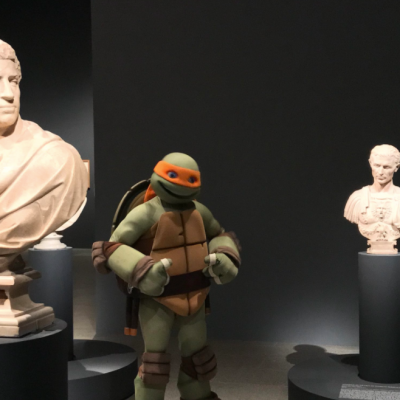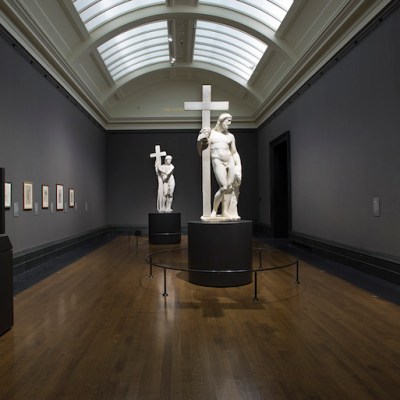From the September 2023 issue of Apollo. Preview and subscribe here.
The artistic competition between Leonardo and Michelangelo to prepare vast murals of battle scenes in the same hall in the Palazzo della Signoria in Florence is well known. Leonardo was to depict the Battle of Anghiari, fought in 1440 between Milan and the Republic of Florence, while Michelangelo was commissioned to paint the Battle of Cascina, which took place in 1364 after bathing Florentine soldiers were startled by Pisan troops. Both battles were Florentine victories that had been transformed into key components of Florence’s image of itself and were central to its mythology. The drawings on this sheet were made by Michelangelo as part of his preparation for the mural. In the autumn of 1504 he was assigned a room to produce the cartoon, and by this time the project was certainly well underway. However, these two battle scenes – the most famous battle scenes not only in the Renaissance but possibly ever – were not finished; today, they are lost.
The cartoons were shown in public and, according to Vasari, every artist in Florence from Andrea del Sarto to Raphael went to see and to study them. For the first time, figures of the human body had a new monumentality; they hold an impressive inner energy, as well as a precision of anatomical understanding that was completely new. No artist had seen heroic figures with this foreshortening, the very complicated torsions and such expressive understanding of anatomy. Added to that, the figures were more than life-sized.
Two Nude Studies of a Man Charging Forward and a Man Turning to the Right (Studies for the Battle of Cascina), (c. 1504), Michelangelo. Albertina Museum, Vienna

Vasari gives a detailed description of the technique of the cartoons. We are told that they were done in black chalk, with some areas heightened with white; however, the cartoon is lost – cut up by the artist. In the 17th century some pieces turned up in a collection in Turin. What does survive is a grisaille copy attributed to Sebastiano da Sangallo that is in Holkham Hall in Norfolk (Vasari mentions a copy, which is possibly the same one). The copy depicts only the central part of the scene. Vasari’s description suggests that at the left side there would have been groups of horsemen, and on the right the battle between the enemy and the Florentine troops.
During the High Renaissance, artists – certainly including Raphael and Michelangelo – made several preparatory drawings and prepared their compositions with great care, moving from first ideas to more definite drawings. The Uffizi has a sketch of a first composition for The Battle of Cascina, but it is different from the solution at the end, so one must presume Michelangelo changed his mind several times. He seem to have developed the composition step by step, changing his ideas as he went along; however, only fragments of the original material are preserved so we can reconstruct the complex history of the composition of The Battle of Cascina only in part.
It seems that at the beginning of the project Michelangelo was quite influenced by Leonardo’s ideas of how to depict a cavalry battle. But as his work progressed, he came to the completely independent, unique solution that is The Battle of Cascina. The drawings in the Albertina – the nude seen from the back, and the rest – are products of a later stage of preparation. At this point Michelangelo had a clear idea of the whole composition and had made an overall drawing showing exactly where he had placed the figures; after that he made these detailed drawings of the individual figures. They are in nearly exactly the same pose as the figures in the final version. They are highly detailed, with all the muscles in great tension; the body’s position and movement are nearly as finely executed. However, in this drawing we can see that the model was studied in Michelangelo’s workshop, from the way the head is drawn. Michelangelo slightly shifted the contour of the face – the outline of the face is doubled, showing he changed the direction of the head to turn it away from the viewer and increase its perspective. The right arm is only partly finished, because it will be more foreshortened in the finished work but also because it is overlapped by an adjoining figure. Michelangelo cared only about the parts of the figures that are visible in the composition.
On the other side of the sheet are two separate figures for which Michelangelo used pen and ink. You can see on the left that he began with a faint black chalk sketch – the face is in black chalk – and then he drew over this with pen and ink. This is the figure that is in the exact centre of the composition. It is probably a depiction of Manno Donati, the soldier who raised the alarm when the Pisans attacked. It is the only figure seen face on in the cartoon. The figure on the right of this sheet is towards the right-hand edge of the group.
Michelangelo started to make the whole of this second figure in black chalk – presumably he started to make a fine outline sketch of the figure in chalk and then later modelled the bodies with pen and ink. In these drawings he obviously concentrated only on the bodies. It’s possible that he made separate drawings in which he treated only the heads of these figures, but we don’t have any such examples.
Black chalk lines create a sense of fluidity, conveying the movement of the muscles

It’s interesting to see on the recto side that he used very fine lines with pen and ink, with precise analytical detail; there’s no way of changing or correcting these lines. But on the other side he uses black chalk, which, because it’s softer, has a more painterly quality. You can see that in very dark areas it becomes a homogenous field of darkness – the individual line is less detailed but there is a stronger impression of the fluidity of the back and the movement of the muscles. From 1503, Michelangelo preferred to use black chalk, which gives a more painterly, more monumental expression to the body. The Battle of Cascina represents the first time in Michelangelo’s career where you see this approach of figures turning and twist- ing around their own axes. Earlier figures – such as the marble statue of David (1501–04) – are seen from the front, fixed from one side. In the composition of The Battle of Cascina you have this temptation to develop the move- ments into the space, and the black chalk makes it easier to have a more homogenous approach to the figure and the surrounding space. The drama of these movements is accented with areas of white that heighten the contrast you can see on the back. It has been suggested these were later additions, but in our view that is not true because Michelangelo very often uses this white heightening, and Vasari says the cartoon was executed using it. These small areas of white mark the highest level of tension of the muscles. If you were to remove them, the drawing would not work any more.
It is interesting to notice some symbols and lines on these drawings. They denote individual muscles with reference lines and symbols in order to clarify their positions from different angles and different levels of tension – each sign always corresponds to a particular muscle. This enabled Michelangelo to really clarify the position of each individual muscle. It is possible that this technique of identifying the different muscles was used later in, for example, the drawings for the Sistine chapel or even for the tomb of Julius II. It is also possible that he wanted to supply a legend with a detailed description for these ciphers and use that for a scientific exposition of the structures of the human body. According to his biographer Ascanio Condivi, Michelangelo intended to write a treatise dealing with all postures and movements conceivable within human anatomy. While no treatise has survived, it is clear that these symbols really are identifying specific muscles in his drawings.
The esteem in which these drawings were held is evident from written marks that appear on the sheet. On the top right of this sheet you can see the inscription ‘Collezione di P. P. Rubens’, so this is one of four drawings by Michelangelo that were in the possession of Peter Paul Rubens, one of the 17th century’s great collectors as well as one of its greatest painters. On the left, at the bottom of the sheet is a later inscription: impossible de trouver plus beau – impossible to find something more beautiful.
Achim Gnann is curator of Italian art from the 15th to the 19th century at the Albertina Museum in Vienna.
‘Michelangelo and Beyond’ is at the Albertina Museum, Vienna, from 15 September–14 January 2024.
From the September 2023 issue of Apollo. Preview and subscribe here.


